VENUSES, TURTLES and other HAND HELD COSMIC MODELS
by Bethe Hagens
bethehagens@gmail.com
1991
Perhaps one of the greatest travesties of twentieth century thinking has been the ascription to ancient humanity of Freudian attributes we have tried (perhaps without much success of enduring validity) to apply to ourselves. 'Baser' aspects of our existence - everything from masturbation to polymorphous perversity - have been pushed backward in time to characterize not only the art but the entire life environment of our ancestors, the Cro-Magnons of the Upper Paleolithic. We seem incapable of even imagining an ancient, fully modern, different-thinking human.
We know these people primarily through their art, a few scraps of presumed clothing, tools, and of course skeletons. Sometime around 30,000 B.C. they made a dramatic appearance throughout Europe and parts of Asia and virtually replaced the local Neanderthal population. Cro-Magnons were fully modern human beings, not only in physiology but in artistic achievement. In addition to elaborate cave paintings, the artifact most commonly associated with them is the sensuous "Venus figurine". The literally thousands of these objects (which range from about one-half to six inches in size) are most often described as fertility figures. The six-inch Venus of Lespuque (Plate 1), carved from mammoth ivory and dated to approximately 25,000 B.C., is often singled out as the most anatomically elaborate and beautifully proportioned.
Art historians have been puzzled by these figurines, which appear to give such exaggerated attention to 'vulvas, large buttocks, and breasts'. One among them, John Onians (1978:1), declares that no culture before or since 'gives such prominence to representations of the entire female body in all its full and naked roundness.' Many women would argue that they have never seen a glorious female in this particular configuration of roundness at any time, however.
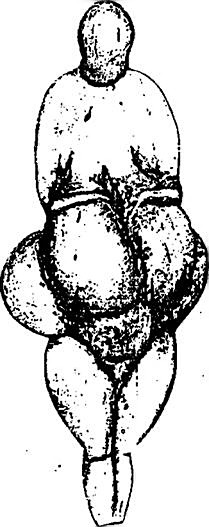
Plate 1. Venus of Lespuque. Six inches high, from Lespuque , France . The carved ivory figurine shown reconstructed.
In his Art History essay, Onians (1978) goes on to dismiss any connection to shamanism, totemism, magical rites, or initiation-and claims that these largely faceless, armless, withered-legged females are symbolic of the importance of 'lovemaking' : Paleolithic pornography, though he does not use that term.
Those areas of her body which are shown in all their rounded perfection are precisely those which would be most important in the preliminary phases of lovemaking, that is, the belly, buttocks, thighs, breasts and shoulders, while the lower legs, lower arms, feet and hands are withered to nothing. There is no real parallel for this enormous imbalance of attention in any later art. Equally without parallel is the total neglect of the face. . . This could again relate to the restriction of interest during lovemaking, or more specifically the restriction to manual loveplay. This explains why the woman is so important in art.
What more perfect description could we find of the nameless, faceless sexuality we fear has risen up within our twentieth century psyches? Anthropologist Marija Gimbutas (1979:8-11) is one of the very few critics who take exception to this hypothesis.
Our European forefathers . . . would certainly be stunned to hear the new hypothesis on the origin of their art (no philosophy, no questions of the beginning of life, birth and death, and resurrection). . . The rounded parts of the female body were the sacred and magic parts of the Creative Goddess, the Giver-of-All.
Even more recent interpretations - coming from a culture that fears AIDS, teen pregnancy, resource scarcity, and emotional commitment - have played down fertility and boosted trade. Arguing that Cro-Magnon probably had too many mouths to feed anyway, anthropologists now feel that the last thing Paleolithic hunter-gatherers would have wanted was increased human fertility. Since the figurines have been found so widely dispersed on the European continent, and since they bear such uncanny geometrical similarity to each other (Plate 2), it is now being proposed that Venuses were a sacred sign of recognition that legitimized the exchange of marriage partners, information, and goods. In a food-scarce environment, the objects may have been essential in cementing new alliances. Stated more directly, the figurines are now thought to have been the currency in a system of Paleolithic triage.
The 'triage' principle, a contemporary policy tool in global development planning, supposes that we live in a food-scarce world. Certain Third World nations are recognized as being capable of reducing population (and thereby food demand) on their own. These nations would then be considered 'good' for additional foreign aid benefit packages. Societies believed to be beyond the point where any possible measures can help combat the consequences of uncontrolled population growth would be classified 'lost causes* and would receive no foreign aid.
The problem with applying this theory to ancient Europe, however, is that paleoclimatologists now suspect that the weather may have been much more moderate than we imagine. Game was apparently plentiful, and fertility was possibly so taken-for-granted that it was not even an issue. There is only evidence of cooperation among Cro-Magnons, and no hint of war or struggle. The real puzzle in this unique period in human history, lasting from approximately 30,000 to 20,000 BCE, is the absence of other artifacts matching the technological sophistication of the cave paintings and Venuses.
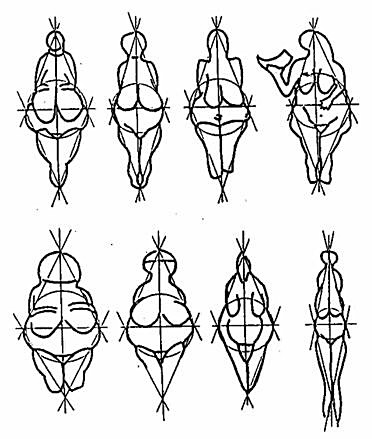
Plate 2. Venus figurines dating back from 14,000 to more than 30,000 BCE show remarkable geometric similarity. (Drawings - Leroi-Gourhan)
It may be that we need an entirely different approach to Cro-Magnon life, one that leads not only to a new appreciation of their lasting achievements but that possibly points to new potentials for our own civilization.
Norman Mailer has as much as said this in his 1969 book Of a Fire on the Moon. Why, he asks, should we be so obsessed with understanding images of the ancient and unknown past at precisely this moment in time - the dawn of the space age? His conclusion: that the mystery of new discovery, the miracle of actually having left the planet and landed on the moon, has forced us to regard the world once again as 'poets' and as 'savages'.
Whether or not we regard ancient humans as 'primitive', or can intuit the romantic implications of the term 'savage' (as used by Claude Levi -Strauss, for example), that ancient world was almost certainly a poetic one. Theirs was a world of metaphor - of odd connection, flashing insight, irreconcilability. It was also, however, the world of the cook, botanist, biologist, and doctor.
If we put ourselves into the living environment of curious, intelligent ancient humans, what might we find? Certainly we would discover a well-developed knowledge of any and all living things in the vicinity, especially since each was a potential candidate for ingestion. We have ample evidence from the cave art left by Cro-Magnon people that they had detailed knowledge of the musculature and skeletal structure of various creatures. The so-called 'X-ray drawings' are particularly illustrative. We also know that significance beyond food value was given to various animals represented on cave walls. While bison are more elegantly and carefully depicted, it is reindeer that were eaten - if we are to make any sense out of the proportional number of bones in what appear to be ancient garbage piles. In addition, food source animals are commonly represented in entry-way and peripheral walls. Depictions of human and 'guardian animal spirits' are reserved for the largely inaccessible inner reaches of the caves.
Leaping forward in time some fifteen thousand years or so, we continue to find a preoccupation with certain plants and animals in the art of prehistoric peoples. This 'art', however, has by this time also found its way into expression as mythology. Certain animals - most often reptiles - are depicted as the 'base' of the phenomenal world. For example, the humble turtle appears as a virtual pedestal for the physical Earth in mythologies as wide-ranging as Hindu, Maya , and native American. Many times the turtle is associated with a female goddess, often Venus. Why should this be?
Taking the lead from archaeoastronomers who have found detailed astronomical information encoded in ancient megalithic structures (such as Stonehenge ), perhaps we can extend the metaphoric astronomy begun by deSantillana and vonDechend (1969) directly into the natural world. The living turtle is a startling example of layered mythology and natural science.
The synodic period of the planet Venus (the time it takes to return to the same place in the heavens when viewed from Earth) is 584 days. Its sidereal period (its real time of orbit around the sun) is 226 days. Earth's year is 365 days. These are approximate numbers, but for our purposes are acceptable. Divided either way, 365/584 or 226/365, the proportional relationship of the two planets* periods is 1:1.6. This proportion, which characterizes much of the natural world, is known as phi or the 'golden mean1. This mathematical proportion (technically 1:1.618) is directly represented in the turtle's carapace (back shell) with its five dorsal plates and eight lateral plates: 5:8 is equivalent to 1:1.6 (Plate 3).
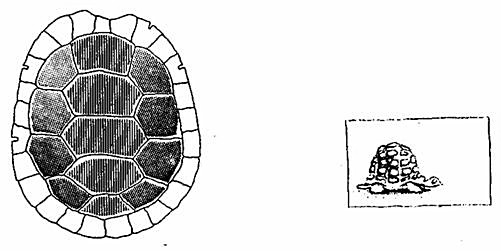
Plate 3. A turtle's carapace (back shell) could have been an early mnemonic device for the golden proportion. It has five dorsal plates (lined segments) and eight lateral plates (dotted segments). 5:8 is equivalent to 1:1.6. Representations of turtles are rarely correct in even this simple detail.
Contemporary representations of the turtle are rarely correct in even this simple carapace detail - and this is probably only the tip of the iceberg in terms of real knowledge metaphorically displayed in the natural world that we have lost and forgotten.
This kind of thinking yields one possible connection between Venus and the turtle. But what of Venus the goddess of love and beauty who is also associated with the turtle and often found standing on its shell? We can possibly find an answer in Cro-Magnon culture and the Venus figurines.
We know from their cave art that Cro-Magnons were curious about animals, and we assume from piles of bones and ash pits that they cooked and ate a number of them. As their artwork also attests, they were skilled at dissection and must have meticulously inspected the anatomies of animals as well as humans for clues as to which physical attributes might account for capacities one species possessed and another did not.
We can go further to speculate that these people craved variety in diet, not only for taste and texture, but to induce subtle differences in body and mind state. While we are just discovering the psychoactive and anesthetic properties of chemicals found in the body parts and venoms of various animals, Cro-Magnons may have honed such knowledge into an exact science. We now know that the flowers associated with Neanderthal burials had psychoactive properties (Leroi-Gouriian 1984). Thus, it seems almost inevitable that both plant and animal substances were a part of Cro-Magnon's spice rack.
This ancient curiosity and experimentation with the natural world has come down to us as a vague philosophy of 'totemism' - the identification of kinship groups (clans) with particular species of animals. A clan's 'totem animal' is now thought by anthropologists to be (among many other things) an object of identification and veneration, a food taboo, a protective spirit, or a shamanic icon for entry into the spirit realm. The list of attributes is long and convoluted. What is clear from a survey of world mythology, however, is that turtles, birds, snakes, and reptiles in general have remained special totems since the most ancient times.
What could be discovered if we were to apply the kind of 'neo-Cro- Magnon' logic Mailer calls for to just one of these animals? As a tentative first step back into the world in which these people really may have lived, the turtle is an interesting starting point.
Turtles have remarkable abilities to withstand drought and famine by retreating into a kind of zombie-like state. They live to prodigious ages, and they can survive both on land and in water. In addition to breathing through a set of lungs, fresh-water turtles can use their mouth cavity in gill-like fashion. They have keen eyesight and can distinguish between colors - though probably lack good long-distance vision. Their shell is strong enough to resist alligator bites, and the leathery skin on extremities wrinkles and folds to allow for extension and retraction of feet and head.
Recent research (Weiss 1988) indicates that one turtle, the two hundred fifty pound Hawksbill from the Caribbean , actually feeds exclusively on crystal - the glass spines of poisonous subtropical sponges! No comparable diet has ever been described for any vertebrate. The turtle's digestive tract is typically full of glass shards that pierce the skin of human researchers yet do no harm to the turtle (whose feces are typically concentrated into solid glass).
The more one learns about turtles, the more magical they seem, incorporating mystical properties within their bodies as well as exhibiting capabilities (especially the zombie-like hibernation) prized in shamans. Folklore about them abounds. A tale from the southern United States attributes twelve different 'tastes' to the turtle: one part tastes like chicken, one like beef, one like frog, rabbit, snake, and so forth. Many native American tribes speak of the North American continent as 'turtle island', and indeed their sweat lodge is intentionally fashioned in the shape of a turtle's carapace.
The more one contemplates the physical body of the turtle, the more its metaphor blooms. The curious pattern on the turtle's plastron (underside) is curiously reminiscent of the ancient diagram of the sephiroth.
What if we assume that the layers of metaphor continue inside the body of the turtle? What better place to look than its brain? One can only speculate as to what ancient cook/biologists must have experienced upon opening the head of such a prodigious creature as the turtle and finding an organ unmistakably reminiscent of both male and female human anatomies (Plate 4). Viewed from the top (dorsal view), the brain resembles a buxom woman; from the side, we see a well-endowed male.
The ancient Egyptian creation myth, the story of the Sky Goddess Nut and her twin Earth God Geb (Plate 5) come immediately to mind. After an endless time of inseparable lovemaking, the twins were pulled apart by the jealous Air God, Shu, and held in unbearable tension of unfulfilled copulation for eternity. One wonders if the native American sweat lodge is really another image of the Goddess Nut, with humans inside desperately trying to bear the intolerable air in an effort to achieve union again with the spirit realm. Physical images such as these are undoubtedly roots of metaphysical dualism.
The discovery of the 'little man' and 'little woman' inside the brain cannot have occurred in only one place, nor can it have happened only with the turtle. Its translation into art may have begun with the recognition that the human midbrain is very similar to that of reptiles. Perhaps Cro-Magnon ultimately discovered that the development or curtailment of various parts of the brain coincided with particular capacities of the species which possessed it (Plate 6). One might have a greater need for smelling, hence an enlarged olfactory bulb. Some might have greater need for long-distance vision, hence an enlarged tectum opticum. The perplexing question, though, is what did they do with this information?
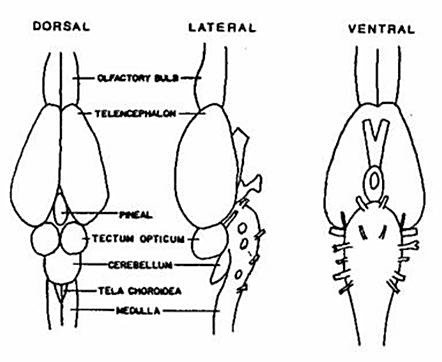
Plate 4. Three views of a turtle's brain. The brains vary, somewhat, according to subspecies involved.
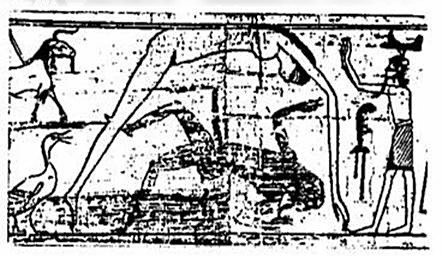
Plate 5. The Sky Goddess Nut arched over her twin Earth God Geb. They are shown held apart by the Air God Shu in this 3000 year old papyrus from Tamienu, Egypt.
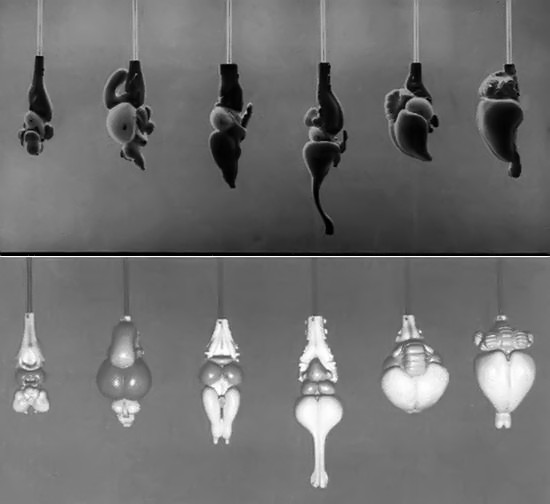
Plate 6. Lateral and dorsal views of animal brains (not proportionally sized), from left: larva of lamprey, trout, frog, alligator, pigeon, rabbit. The various lobes equip the animal for autonomic nervous control, motor reflexes, vision, thinking, and smelling.
There are several strongly warranted possibilities, given evidence from Cro-Magnon cave art and other remnants of physical culture. First, they systematically (perhaps ritually, in a sacred ceremony in the innermost cave sanctums) ate brains. While there are several new theories regarding the possibility that skulls were punctured by sabre-toothed tigers, the skulls of Peking Man appear to have been punctured for brain extraction. When we begin to ask not only who might have done this, but why, we may be able to expand notions of culture and technology into biology in ways that will begin to bridge our rigid tradition of metaphysics. As we advance in our contemporary studies of brain chemistry and function, we will undoubtedly rediscover vast medicinal and psychoactive substances in brains. Whatever experiences such substances opened to ancient peoples, they were the core of their cultural existence. Such an emphasis on spiritual technology, if you will, would account for the lack of evidence of a sophisticated material technology among these people.
Second, Cro-Magnons carved and traded brain images - those very objects we have labelled 'Venus figurines' - for thousands of years. They constitute the remains of an ancient transportation network, both non-polluting and non-material. They are the essence, the 'elite power base', of shamanic spirit travel.
Are these conclusions truly warranted? A comparison of Venus figurines with brains reveals a number of correspondences. Just as brains range in size, so Venus figurines range from about three-quarters of an inch upwards to about seven inches. While some of the Venuses are clearly female icons, they also seem to be variations on a 'brain theme' since they remain geometrically regular - like brains. There is obviously an enormous amount of research that could be done here to unite anthropology, neuro-physiology, and biology into a future environmental science.
Shamanic spirit travel is perhaps the most exciting implication of the brain hypothesis, and the Venus figurines may indeed be our means to prove this element in the culture of our ancient forebearers. We can propose that ancient spiritual technicians carved brain replicas that encoded characteristics of the real or 'ideal' (stylized - for example, 'feathered serpent') totem one wished to contact and 'become'. In other words, a brain replica might not correspond to any particular animal but might incorporate the relative size and development of brain parts believed necessary to perform various physical activities (e.g. prolonged existence in hibernation, superb smell, visual acuity, and so forth). The Venus figurine, then, would serve not only as a meditative icon - but perhaps as a recipe. Perhaps the various parts of an animal's brain were discovered to produce predictable 'spirit travel'. The dynamics of that journey could then be altered and fine tuned, perhaps with other brain parts, much as we season a stew. The truly great shamans would have been the renaissance people of their day - biologists, cooks, healers, priests, and artists. Remnants of their legacy may even constitute the base of great books of esoteric wisdom such as the Egyptian Book of the Dead. If this hypothesis is correct, we should be able to recreate these concoctions using Venus figurines as our guides.
The Venus of Lespuque, deemed by art historians to be the oldest and finest example of the figurines, embodies a host of golden mean proportions as well as exquisite symmetry. Readers must make up their own minds on the issue of how closely it approximates a turtle's brain, but the resemblance is startling. It may be that the turtle took on such cosmic significance because its brain displays universal geometric proportions and metaphoric sexual duality; its body exhibits equally significant astronomical information; and it is able to perform almost unparalleled physical processes as part of its normal survival activities.
To the extent that we are able to analytically 'decode' the physiological symbolism of Venus figurines and other prehistoric artifacts (Plate 7), we may unlock an entire body of knowledge of brain chemistry and mind/body altering substances. We may be able to reenter the mind of ancient man and re-experience the sacred dreams and visions which sustained Cro-Magnon culture. Somewhere in ancient history this knowledge was lost. Perhaps the true meaning of objects such as Venus figurines was confined to a long-gone priesthood or sisterhood. If they are today's Paleo-porn and tomorrow's investment portfolio, it is not impossible that all of these meanings were a part of the Venus/brain metaphor.
The reptilian brain may long ago have been shamanically perceived as an archetypal form - a world generating device of some sort: a template. We may be rediscovering this very same archetype; computer-based graphics systems have produced a topological form of four-dimensional reality that allows the viewer to peer into the form's interior. It is called the Etruscan Venus. These are the kinds of discoveries, undoubtedly, that lock science and religion like the two tiny figures fused within the brain of the world hero, the turtle.
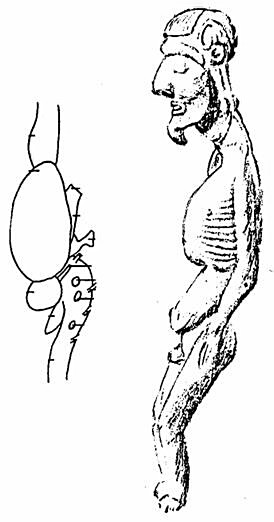
Plate 7. The emaciated god-figure from Easter Island bears some resemblance, also, to the lateral view of a turtle's brain. Much art of the Pacific Islands may well lend itself to this sort of physiologic anlaysis.
ReferencesGimbutas, Marija. 1983 Vulvas, breasts, and buttocks of the goddess creatress: commentary on the origins of art. Creative Woman 6(4), 8-11.
Leroi-Gouriian, Artette. 1984 The flowers found with Shanidar IV, a N eanderthal burial in Iraq . Science 190: 562-564.
Mailer, Norman. 1969 Of a Fire on the Moon. Boston : Little Brown and Company.
Onians, John and Desmond Collins. 1978 The origins of art. Art History 1( 1), 1 -25.
Santillana, Georgio de and Hertha von Dechend. 1969 Hamlet's Mill: An Essay Investigating the Origins of Human Knowledge and its Transmission through Myth. Boston : David R. Godine.
Weiss, R. 1988 Glass eating turtle fills unique niche. Science News 133, 70.
These files are protected by a Creative Commons license. Any of the information and graphics may be copied and freely shared as long as (1) the author and source are cited; (2) the Creative Commons license is acknowledged; and (3) the material is not sold. Please contact me if you have a question about using any of these materials.